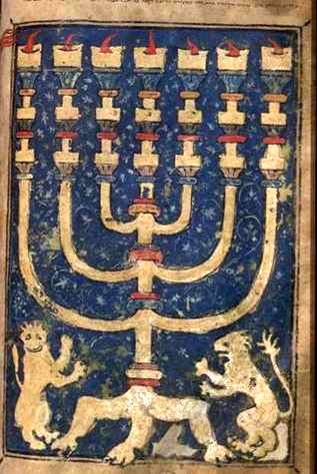Img. ID: 19590

Vol. I, fol. 65: Full-page illustration of the seven-branched gold candelabrum (menorah) illustrating the biblical text of Parashat Trumah (Ex. 25:31-37) and the preceding commentary and explicit on fol. 64v: The the making of the menorah and its interpretation is complete (נשלם מעשה המנורה ופתרונה). The candelabrum is executed in burnished gold leaf on an alternating magenta, green and blue ground.
The candelabrum has three legs: the central shaft rests on a rectangular box-like base and the two on either side have three steps, alluding to the commentary but not following the text. It explains that the base of the shaft is box-like and three legs spring from it (fol. 64v, 1st column: (ירכה הוא הרגל שלמטה העשוי כמין תיבה (ושלוש רגלים יוצאים הימנה למטן.
The lower part of the shaft is decorated with a knop and twin leaves (כפתור ופרח), a fleurs-de-lis and a bowl (גביע). Its upper part is adorned with three superimposed bowls, a knop with twin leaves topped by an oil container (בזיך) and an upright flame.
From three knops on the shaft issue diagonally three pairs of branches which curve upwards, though the text explains that they continue diagonally to the height of the shaft (I:64v, 1st and 2nd columns: וששה קנים "יוצאים מצדיה לכאן ולכאן באלכסון נמשכין ועולין עד כנגד גובהה של מנורה שהוא קנה האמצעי). Moreover, each pair is diminishing in size the further from the shaft, contrary to the commentary, which mentions equal height (I:64v, 2nd column: לפי שהיה גובה ראשי ראשיהן שוה לגובה של קנה האמצעי השביעי).
The branches are each similarly decorated with three bowls and a knop with twin leaves. Their flames bend towards the central shaft, following the commentary (I:64v, 3rd column: ששת הנרות שבראשי הקנים היוצאים מצדיה מסובין כלפי נר האמצעי).
The plummet underdrawing is clearly visible.
| Cod. hebr. 5/I-II (Steinschneider 1895, No. 5)
The full-page menorah was executed by the artist who depicted all the illustrated panels of our manuscript (fol. 65).
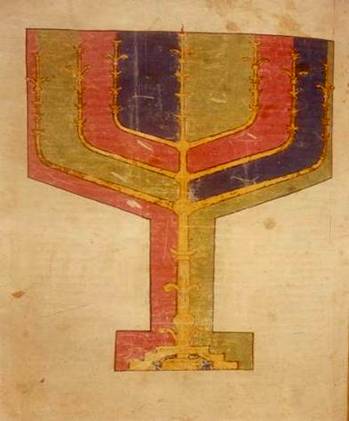 |
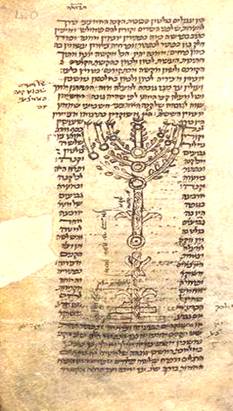 |
| Fig. 1: The menorah, Munich Rashi's Commentary on the Bible, Munich, BSB Cod. hebr. 5, fol. 65 | Fig. 2: The menorah, Rashi’s commentary on the Pentateuch, France, early 13th century, Oxford, Bodl.Lib. Opp. Add. 2069, fol. 40 (van Boxel and Arndt 2009, p. 105) |
An example of a contemporary Rashi menorah is found in a French manuscript executed by the scribe within the text column (fig. 2). Although in general shape the latter does not resemble ours, there are two details which should be noted. In both the flames bend towards the centre (I:64v, 3rd column), and the base is stepped. In our menorah, which has three legs, those on either side have three steps. This does not exactly follow Rashi's text which describes a box, from which three legs spring (I:64v, 1st column; cf. figs. 3, 6). Moreover, "there was a stone before the menorah with three steps; the priest stood on this to trim the lamps" (fig. 3; BT Menahot 29a; Tamid 30b; Narkiss 1982 p. 102). However, our artist depicted a box as the base of the centre leg and three steps each for the flanking ones. In the French menorah (fig. 2) the base consists of four steps (see Jerusalem, CJA Documentation).
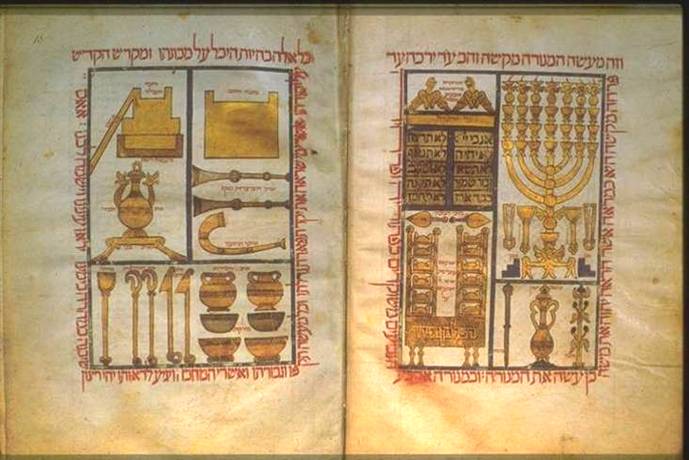 |
| Fig. 3: Sanctuary Implements, Perpignan Bible, Perpignan, 1299, Paris, BnF hébr. 7, fols. 12v-13 (Sed-Rajna 1994, Cat.12) |
The depiction of a menorah survives in about thirty Spanish Bibles from the end of the 13th century on, mostly as part of an array of Sanctuary Implements at the beginning of Bibles (fig. 3; Narkiss 1999, p. 82). The early dated examples are two Bibles, one from Toledo of 1277 (Parma, Bibliotheca Palatina, Parm. 2668, fols. 7v-8), the other from Perpignan of 1299 (fig. 3). The Spanish menorah, which is based on the biblical text as well as on the commentaries of Rashi and Maimonides (Mishneh Torah, VIII, I, 3:1-11) influenced the full-page menorah in Ashkenaz and Italy in the 14th and 15th centuries, usually depicted in manuscripts other than the Bible (Narkiss 1999, pp. 81-84, figs. 3, 4).
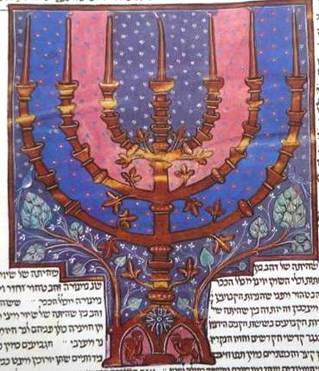 |
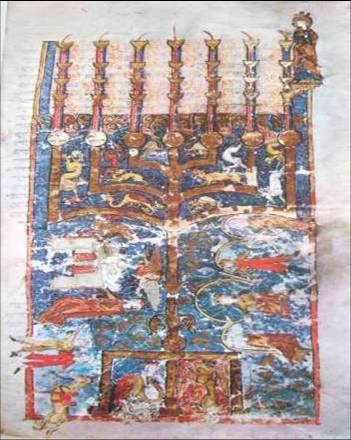 |
| Fig. 4: The menorah, Maimonides Mishneh Torah, North-east France, 1296, Budapest, MTAK Kaufmann Coll. A. 77/I-IV, vol. III, fol. 3v (Scheiber 1984, pp. 103-4, pl. XXXV) | Fig. 5: The menorah, Poligny Pentateuch, Poligny, 1300, Paris, BnF hèbr. 36, fol. 283v (Narkiss 1984, pl. 24) |
Two other examples from France can be cited from the end of the 13th century, the Maimonides Mishneh Torah of 1296 from North-east France (fig. 4) and a Pentateuch of 1300 from Poligny (fig. 5). The Perpignan and the Maimonides menorot (fig. 3, 4) have curving arms, but the Poligny ones recall the angular arms of our menorah.
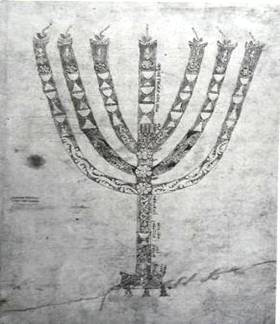 |
 |
| Fig. 6: The menorah, Rashi's Commentary on the Pentateuch, Franconia, c.1250, Paris, BnF hébr. 155, fol. 110v | Fig. 7: Aaron and the menorah, Franconian Bible, South Germany, Franconia (?), 1294/5 Paris, BnF hébr. 5, fol. 118 (Sed-Rajna 1994, Cat. 87) (Sed-Rajna 1994, Cat. 71) |
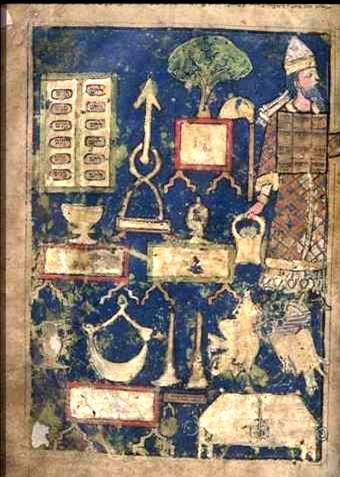 |
|
| 8: Sanctuary Implements; Aaron and the menorah, Regensburg Pentateuch, Regesnburg, c.1300, Jerusalem, IM Ms. 180/52, fols. 155v-156 (Jerusalem, CJA Documention) | |
Fig.
Three examples from south Germany of the 13th century are worth noting. One is a Rashi commentary on the Pentateuch from Franconia of c.1250 (fig. 6); another is a Bible with a massoretic menorah in micrography dated 1294/5 also from Franconia (fig. 7); and the third is a menorah depicted in a Pentateuch from Regensburg of c.1300 (fig. 8). All three have curved arms as in the above examples (figs. 2-4) except for our menorah and the Poligny one (figs. 1, 5). Common to them all are the flames bending towards the centre. As regards the base, however, all examples including our menorah have three legs, except for the early Rashi one (fig. 2). It should be added that the Franconian Rashi of c.1250 (fig. 6) has a box-like base from which spring three legs, somewhat resembling those in the later Perpignan Bible (fig. 3). Both menorot illustrate Rashi's text literally.
 |
 |
| Fig. 9a: Sanctuary Implements, Peter Comestor Historia Scholastica, Aragon, 1299 Madrid, BNE Res.199, fols. 6v-7 (The Bridgeman Art Library) www.bridgemanart.com AIS 291896 (pictures) | Fig. 9b: the menorah |
Illustrations of the seven-branched menorah have appeared in biblical as well as non-biblical Christian manuscripts since the Carolingian period (Kühnel 1999, p. 117). A good example is a menorah in the Latin Historia Scholastica of 1299 from Aragon by Petrus Comestor (c.1100-1179 from Troyes; Migne PL193:1172-3; fig. 9). It appears in two facing pages in an array of Sanctuary Implements, recalling that in the Hebrew Spanish Bibles (fig. 3). Although differing in detail, Comestor's menorah stands on three legs and the flames bend towards the centre, two features which are mentioned in Rashi's commentary and depicted in Hebrew manuscripts.
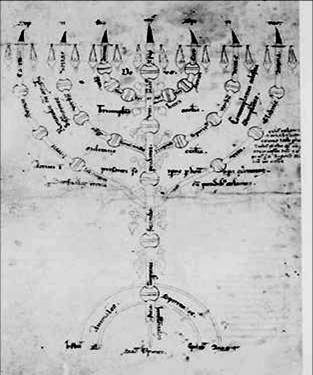 |
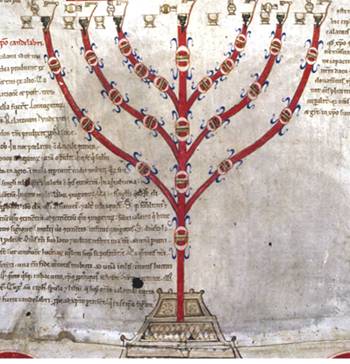 |
| Fig. 10: The menorah, Petrus of Poitiers, Compendium historiae in geneologia Christi, Bavaria, first third of 13th century, Munich, BSB clm. 8715, fol. 6v, (Klemm 1998, Cat. 23, fig. 94) | Fig. 11: The menorah, Petrus of Poitiers, Compendium historiae in geneologia Christi, Northern France, 1200-1250, Cambridge (Mass.), Harvard University, Houghton Library Typ 0216 (roll) (Digital Scriptorium, app.cul.columbia.edu)
|
The Compendium historiae in geneologia Christi written by Petrus of Poitiers (b.1130; Klemm 1998, Cat. 23) of the first third of the 13th century from Bavaria has a seven-branched menorah (fig. 10). However, the decorative elements and their order differ from ours. Furthermore, the oil containers hanging on either side of each bowl at the top of the branches are rare. Nevertheless, the three legs which form the base of the menorah and the six flames bending towards the centre are common to both. These features suggest the influence of Rashi's commentaries on Petrus Comestor and Petrus of Poitiers, who belonged to the Augustinian Canons Regular of Saint Victor in Paris. It has been shown that the Victorines consulted the Hebraei and based some of their explications on Rashi (Sed-Rajna 1993/4, pp. 155-57). Petrus' Compendium was also copied as a roll. One example, written in northern France 1200-1250 (fig. 11), has an interesting three-stepped box-like base but no flames. Moreover it has diagonally set arms as distinct from the curved branches of the Munich Compendium (fig. 10). Rashi in his commentary (I:64v, 1st and 2nd columns) explains that the branches spring diagonally from the central shaft and are all of the same height.
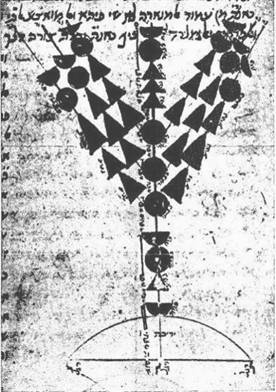 |
| Fig. 12: Maimonides' original drawing of the Temple menorah, Perush Hamishna, between 1168 and 1180 (Kafih 1967, vol. 3, p. 69) |
A schematic drawing by Maimonides in his own hand (between 1168 and 1180) of the menorah in Perush Hamishna (fig. 12) shows straight diagonal branches which terminate at the same height, as described by Rashi (see Bloy (אל מול פני המנורה. However, in our Rashi manuscript the branches of the menorah emerge diagonally from the shaft but then curve upwards. Moreover, they are not all of the same height, as stated in the text, but increase in height the closer they are to the shaft.
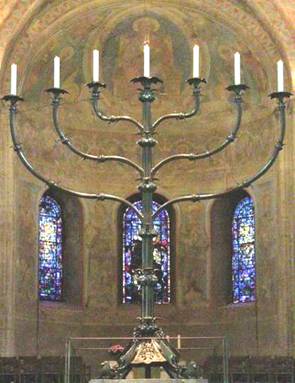 |
| Fig. 13: Bronze menorah (height 4.80 m.) Brunswick Cathedral, 1170-80 (Monumenta Judaica 1963-64, fig. 86) |
A similar form of branches is found in the large bronze candelabrum of Brunswick Cathedral of 1170-80 (fig. 13). As in our menorah, the branches are not of equal height. However, instead of a box its base is a cone from which three legs emerge (Bloch 1974, pp. 44-49). In conclusion, our Rashi menorah does not illustrate the commentary, except for the flames bending towards the centre and the three legs, features which are commonly depicted in Hebrew and Latin manuscripts. The branches do not emerge diagonally as the text states, nor are they of the same height. Even the base is unique, with a box-like centre and three steps on either side, probably a misinterpretation of the separate stepping stone before the menorah. The resemblance to the Brunswick candelabrum




